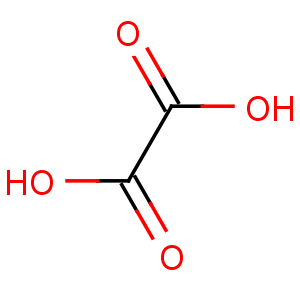Title: Oxalic Acid
CAS Registry Number: 144-62-7
CAS Name: Ethanedioic acid
Molecular Formula: C2H2O4
Molecular Weight: 90.03
Percent Composition: C 26.68%, H 2.24%, O 71.08%
Line Formula: (COOH)2
Literature References: Present in many plants and vegetables, notably in those of the
Oxalis and
Rumex families, where it occurs in the cell sap of the plant as the potassium or calcium salt. It is a product of the metabolism of many molds. Several species of
Penicillium and
Aspergillus convert sugar into calcium oxalate with 90% yields under optimum conditions. Oxalic acid was formerly manuf by fusion of cellulose matter, e.g. sawdust, with NaOH or by oxidation with HNO3; it is now made by passing carbon monoxide into concd NaOH or by heating sodium formate in the presence of NaOH or Na2CO3: Wallace,
US 1602802 (1926); Beckman,
US 2687433 (1951 to Allied Chem.). Efficient laboratory prepn of anhydrous form: H. T. Clarke, A. W. Davis,
Org. Synth. coll. vol. I, 421 (2nd ed., 1941). Toxicity study: E. H. Vernot
et al., Toxicol. Appl. Pharmacol. 42, 417 (1977).
Review: Wilson, "Miscellaneous
Aspergillus Toxins" in
Microbial Toxins vol. VI, A. Ciegler
et al., Eds. (Academic Press, New York, 1971) pp 268-273; C. A. Bernales in
Kirk-Othmer Encyclopedia of Chemical Technology vol. 16 (Wiley-Interscience, New York, 3rd ed., 1981) pp 618-636.
Derivative Type: Dihydrate
Properties: Monoclinic tablets, prisms, granules.
Poisonous! d418.5 1.653. mp 101-102° giving off water of crystn and starting to sublime. pK1 1.27; pK2 4.28. pH of 0.1
M soln 1.3. One gram dissolves in about 7 ml water, 2 ml boiling water; 2.5 ml alcohol, 1.8 ml boiling alcohol, 100 ml ether, 5.5 ml glycerol. Practically insol in benzene, chloroform, petr ether. d417.5 of aq solns: 1% (w/w) 1.0035; 3% 1.0105; 5% 1.0175; 10% 1.0350; 13% 1.0455. Oxalic acid can be dehydrated by careful drying at 100°, but considerable loss occurs through sublimation; this, moreover, is harmful to the oven. LD50 orally in rats (5% solution): 9.5 ml/kg (Vernot).
Melting point: mp 101-102° giving off water of crystn and starting to sublime
pKa: pK1 1.27; pK2 4.28
Density: d418.5 1.653; d417.5 of aq solns: 1% (w/w) 1.0035; 3% 1.0105; 5% 1.0175; 10% 1.0350; 13% 1.0455
Toxicity data: LD50 orally in rats (5% solution): 9.5 ml/kg (Vernot)
Derivative Type: Anhydr oxalic acid
Properties: Crystallized from glacial acetic acid, is orthorhombic, the crystals being pyramidal or elongated octahedra. Hygroscopic, mp 189.5° (dec). Sublimes best at 157°. At higher temps dec into CO2, CO, formic acid, and H2O. d417 1.90. 100 g of aq soln satd at 15° contain 6.71 g, at 20° 8.34 g, at 25° 9.81 g.
Melting point: mp 189.5° (dec)
Density: d417 1.90
CAUTION: Potential symptoms of overexposure by ingestion are corrosion of alimentary tract mucosa; localized pain; vomiting, shock, hypotension, cardiovascular collapse; headache, muscle cramps, tatany; convulsions, stupor, coma; kidney damage. Direct contact may cause eye, skin and mucous membrane irritation; eye burns.
See NIOSH Pocket Guide to Chemical Hazards (DHHS/NIOSH 97-140, 1997) p 238;
Clinical Toxicology of Commercial Products, R. E. Gosselin
et al., Ed. (Williams & Wilkins, Baltimore, 5th ed., 1984) Section III, pp 326-328.
Use: As analytical reagent; in calico printing and dyeing; for bleaching straw (hats) and leather; removing paint or varnish, rust or ink stains; cleaning wood; manuf oxalates; blue ink; celluloid; intermediates and dyes; in metal polishes; in indigo dyeing; in purifying methanol; for decolorizing crude glycerol; for stabilizing hydrocyanic acid. As a general reducing agent; in ceramics and pigments; in metallurgy as cleanser; in the paper industry; in photography; in process engraving; in the rubber mfg industry; in making glucose from starch; as condensing agent in organic chemistry.
In vitro blood specimen anticoagulant.
Therap-Cat-Vet: In 5% solution with 5% malonic acid as hemostatic agent.

